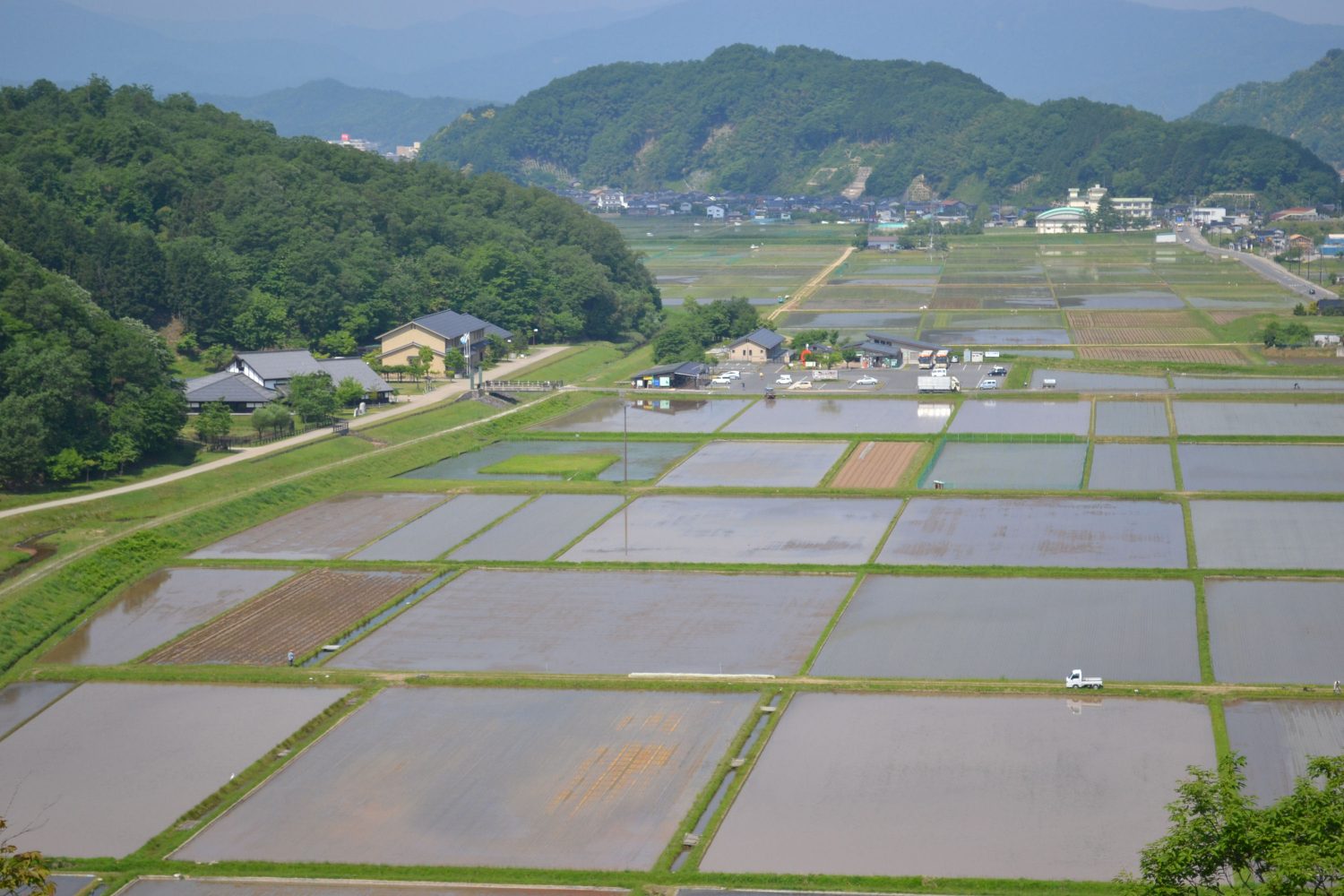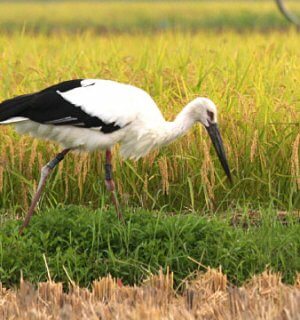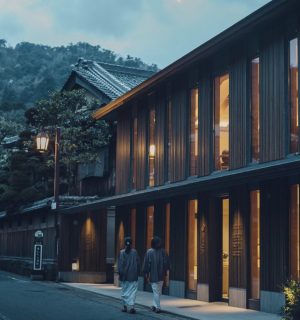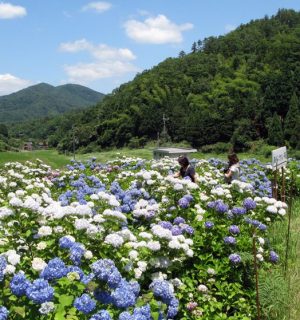2021 TOP 100 GOOD PRACTICE STORY
-
TOYOOKA CITY HAS BEEN SELECTED AS PART OF THE 2021 TOP 100 DESTINATION SUSTAINABILITY STORIES BY GREEN DESTINATIONS
Issues faced
The Oriental White Stork (Ciconia boyciana), a stork species native to East Asia and Southeast Russia with only 3,000 birds remaining in the world, has been considered an auspicious symbol in Japan since ancient times. The stork once lived in regions all over Japan, but, in 1920, it could no longer be found anywhere except in small regions such as Toyooka City, and became an endangered species. Additionally, due to Japan being under enormous economic strains in the post-war era, modern methods which use toxic pesticides and chemicals were developed to increase food production in the nation. Continued progress in economic development resulted in the natural habitat of the birds to disappear. A polluted and barren environment meant fewer and fewer creatures could live there. With their home and food source gone, the last of the storks died in 1971, and the birds disappeared from the skies of Japan entirely. Toyooka City, the last place where storks could be spotted in Japan, felt an enormous sense of guilt and responsibility for the massive ecological loss which had occurred. Determined to right the wrongs of humanity, Toyooka City set out to create a town where both storks and people could live together happily again. Finally, the city made a promise to the birds to return them to the wild, and began a series of breeding initiatives.
Methods, steps and tools applied
Before the Oriental White Stork went extinct, in 1965 remaining storks were captured and rounded up together so that an initiative to breed the species could commence. However, the poison from the pesticides had a toxic effect on the birds’ bodies, rendering them infertile.
The project was rejuvenated when the city received a donation of Oriental White Storks from Russia (then, the former Soviet Union) in 1985. In 1989, after four years – miraculously – a baby chick was born. Afterwards, the breeding process was successful, and the number of storks increased. As the next step of the plan, determined to right the wrongs of humanity and return the birds back to the wild, Toyooka City set aside development plans in town where people and storks could peacefully co-exist. In order to achieve this, they needed to create a more hospitable environment for storks to live in.
The city first began the construction of organic rice paddies, wetlands, and biotopes. While creating these habitats, people also developed Stork Friendly Farming Methods in place of previously harmful strategies. These pesticide-free methods allowed for the creation of a more suitable environment for storks, as well as providing people safe and organic “Stork Natural Rice”.
The core tenets of these methods lie in water level control. In Japan, rice paddies are normally drained in late June, but Toyooka farmers extend this process, waiting until tadpoles have sprouted legs and fully matured into frogs. This way, even if harmful insects come, the frogs will eat them, acting as a natural “pesticide”.
As this process continued, finally, in 2005, the first group of storks was released into the wild. After 40 years of long, hard work, Toyooka could make good on its promise to return the storks to their home.
In 2007, the first stork pair was able to successfully breed in the wild on their own in Japan for the first time in 43 years. The city built artificial nest towers to encourage more stork couples to breed in the wild. The enormous pine trees that storks originally built their nests in became scarce, so now these artificial towers are used by Japanese stork pairs to breed in the wild. In Toyooka, there are currently 26 such towers, which are emblematic of how people and storks have come to live together.
Key success factors
In 1999, Hyogo Prefecture established the Hyogo Park of the Oriental White Stork to act as both a research/breeding site and a place to prepare storks before their release into the wild. There, researchers studied the Oriental White Stork on a deeper scale, as the research of the species is quite a new affair. The following year, in 2000, the Stork Museum was created by Toyooka City as a facility to spread public awareness of storks and the environment. Moreover, in 2002, the city formed the Oriental White Stork Coexistence Division at the Toyooka City Hall to oversee all activities related to “creating an environment in which storks can live”. Additional initiatives by the division include creating a habitat for storks, such as the construction of wetlands, biotopes, and fish ladders, and chemical/pesticide-free farming methods.
The local citizens were involved in many of these plans, such as maintaining the wetlands, promoting environmental education (starting with the storks), and farmers changing their agricultural methods. The city was able to carry out its vision and make it a reality through the help of farmers and the cooperation of citizens and local organizations. After thinking about the kind of world they wanted their grandchildren and great-grandchildren to grow up in, farmers were convinced to help create a brighter future both for people and animals.
Lessons learned
It is crucial to protect endangered species. The Oriental White Stork sits at the top of its food chain, and the continued presence of the bird demonstrates a healthy environment rich in biodiversity. It is quite easy to destroy one’s environment, but it is a much more difficult task to fix it. It takes a considerable amount of time, energy, and money to restore nature into a place where storks can live. For this project, the city learned that environmental conservation and revitalization must be conducted simultaneously. Moreover, a place where storks can reside is also a wonderful environment for humans. Economic development and environmental protection do not have to be mutually exclusive. In fact, Toyooka City learned that the two are not only able to coexist in harmony, but actually complement one another in a virtuous cycle (known as environmental economics), one that ended up involving several different people.
Results, achievements and recognitions
Nowadays, 225 Oriental White Storks can be seen all over Japan once again, especially in the rice fields of Toyooka City. This is a massive effort, the likes of which not seen anywhere else in the world. In 2007 there was only one mating stork pair in the city, but in 2020 this number grew to 15.
The amount of other living creatures in rice paddies, such as frogs and fish, has also increased, and Toyooka’s natural environment is flourishing. Toyooka is a host to 280 different bird species. There are a total of 633 different species which can be seen in Japan, and Toyooka’s biodiverse environment includes 45% of that total.
Moreover, storks have become a symbol and mascot thoroughly tied to the city. The city managed to make coexistence with nature one of its core tenets, which has had a massive influence on how people go about their daily lives.
In order to preserve the storks’ feeding grounds, pesticide-free farming started among a group of farmers and then gradually spread. In 2003, there were 5 farmers who used Stork Friendly Farming Methods, and there were 0.7 hectares of pesticide-free land. Nowadays, these numbers have grown to 202 farmers and 425.7 hectares of land which uphold the “Stork Natural Rice” brand. Stork Natural Rice is provided at schools, restaurants, and inns in Toyooka, and, as of 2016, is even being exported to customers abroad. As of 2000, a total of 22.3 tons of rice has been exported to 8 different countries and been a financial success. Toyooka’s efforts have expanded into the rest of the country as well, leading to the creation of the national NPO Oriental White Stork Society of Japan.
Toyooka received the first annual Biodiversity Japan Award in 2009 from the AEON Environmental Foundation, a major Japanese corporation's institution which gives grants and awards to organizations and individuals for conservation fieldwork in Japan and developing countries, for its Stork Friendly Farming Methods initiative used to produce Stork Natural Rice. Additionally, Toyooka’s Maruyama River and surrounding rice paddies were designated a wetland of international importance by the Ramsar Convention in 2012.
The city also hosts ecotourism projects to promote education on Oriental White Storks for a global audience. In 2018 and 2019, Toyooka participated in the international British Birdwatching Fair (Birdfair), where the city got the chance to show the documentary “KOUNOTORI” and had a booth to promote the story of the stork. Furthermore, the city also created an eco-tour about storks for overseas tourists, promoted wetland protection-based tourism, and organized an annual international school visit for children to learn about the environment.
In 2018, a total of 5 million visitors made their way to the Stork Museum, where storks can be observed from up close, which is also connected to local tourism. Additionally, the local citizens have prepared a “Stork Tourism Guide” for visitors, allowing more people to learn about the initiative and contribute to its efforts while also having fun.
Visitors to the museum can make donations and, each time someone contributes to purchasing Stork Natural Rice, a portion of the profit is poured into research and initiatives for the protection of storks. Microeconomics on a local scale and environmental protection benefit hand-in-hand in a virtuous cycle. Finally, initiatives to restore the stork species have spread from Toyooka and begun in 7 prefectures and 10 cities outside of Toyooka as well, including Echizen City, Fukui Prefecture and Unnan City, Shimane Prefecture in Japan.




